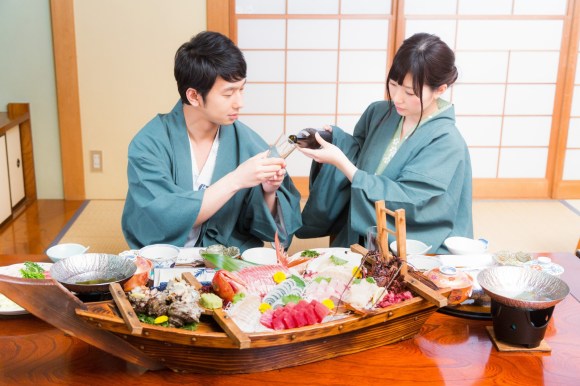
If you’ve stayed at a traditional Japanese inn with your partner, chances are you’ve experienced this custom before.
In Japan, nothing transports you back in time to a bygone era like a stay at a ryokan, or traditional Japanese inn. Often found in rural areas, this type of accommodation typically features tatami mat rooms, communal baths and dining areas, and yukata outfits, which visitors wear during their stay while being served by owners and staff in traditional clothing.
During mealtimes, guests are treated to sumptuous meals, which are often laid out on a traditional low table before they arrive, with things like tea, soup and rice served upon arrival. One of the many traditions guests encounter while staying at a Japanese inn is the fact that at mealtimes, they’ll usually be given a large portion of rice in a tub with a lid, called an “ohitsu”, which is placed beside the table with a shamoji rice paddle for serving, so that the diners can eat as much rice as they like throughout the course of the meal.
▼ The ohitsu is part of the service you’ll encounter while dining at a Japanese ryokan.
While it might seem like the ohitsu adds a nice touch to the meal, it’s actually become the subject of intense debate online recently, as the ohitsu is usually placed next to the woman at the table when she’s with a male partner, as it’s assumed she’ll be the one serving him rice during the meal.
While the traditional role of women as housewives still persists throughout a lot of rural areas in Japan, attitudes are changing, and some people are now questioning whether or not the custom of placing the ohitsu beside women dining with husbands or boyfriends should continue.
Twitter user @otakukonyakusya recently brought the “ohitsu problem” to everyone’s attention with this tweet, where she explains that on a recent stay at a ryokan with her husband, no matter whether she sat in the “kamiza” position (Japanese seating position usually reserved for the most senior member of a group, furthest away from the door) or the “shimoza” position (Japanese seating position reserved for the least senior member of a group, closest to the door), the ohitsu was always placed beside her every time. According to @otakukonyakusya, she says she was fine with it, but she’s worried about how this will go over with foreign tourists. She is concerned and she really wants the practice of placing the ohitsu next to the woman to stop.
夫と一泊二日旅行に来てるんですけど、旅館で毎回毎回、上座に座ろうが下座に座ろうが妻の方に置かれるおひつとしゃもじが辛くてね😂
— LiB羊 (@otakukonyakusya) October 21, 2017
私はもういいんだけど、外国人観光客にもまさか同じことしてるんじゃねえだろうなって心配になる。お願いだからやめてね、本当…。心配だよ。 pic.twitter.com/fq2az5CGTm
Seeing as she and her husband changed their seating positions as an experiment to see where the ohitsu would be placed, the placement of the ohitsu appears to have nothing to do with the seating position, which has prompted many online commenters to label the custom as sexist.
The topic has sparked intense debate online, with some women saying this was annoying sexist behaviour, while others said it didn’t bother them in the slightest. Other women said they wanted to serve rice to their husbands.
One comment that stood out came from a ryokan staff worker, who said that it’s not necessarily about the ohitsu but the shamoji serving spoon that comes with it, which they’re taught shouldn’t be placed near the male guest when he is dining with a woman. If they fail to do this, some guests have been known to lose their temper, which is the reasoning behind its placement.
One of our very own Japanese-language reporters, who used to work at an upscale restaurant, also backs up this claim by saying that he was taught to always place the ohitsu and shamoji next to the female diner.
In amongst all the hundreds of comments left online, some people pointed out that a happy solution to the problem would be to simply place the rice tub and serving spoon in between the male and female guests. This certainly sounds like a good way to solve the ohitsu problem, as both guests would be able to serve themselves individually and not have to request, or wait to receive, an extra serving from their other half.
Still, that approach wouldn’t necessarily appeal to couples who choose to stick to their traditional roles, so perhaps a gentle question from the server to the guest about placement preferences would be the ideal solution.
The one thing sorely missing from the debate was a voice of opinion from foreign tourists who have actually experienced this custom themselves. So let us know your thoughts about the ohitsu problem – does it bother you or do you think it’s a Japanese custom that doesn’t need to be changed? Let us know in the comments section below!
Source: My Game News Flash
Featured image: Pakutaso
Insert image: Pakutaso
[ Read in Japanese ]


 Hilton Japan apologizes for “disrespectful” ad disparaging traditional Japanese inns
Hilton Japan apologizes for “disrespectful” ad disparaging traditional Japanese inns Rakuten Travel reveals the top 5 best-rated, off-the-beaten-track Japanese ryokan inns
Rakuten Travel reveals the top 5 best-rated, off-the-beaten-track Japanese ryokan inns How should you use the small hiroen in a Japanese ryokan hotel room?
How should you use the small hiroen in a Japanese ryokan hotel room? The top three ranking of hotel “poster cats” that Japanese travelers are most eager to meet
The top three ranking of hotel “poster cats” that Japanese travelers are most eager to meet This remote island guest house may have converted our “private rooms only” traveling reporter
This remote island guest house may have converted our “private rooms only” traveling reporter McDonald’s new Happy Meals offer up cute and practical Sanrio lifestyle goods
McDonald’s new Happy Meals offer up cute and practical Sanrio lifestyle goods All-you-can-drink Starbucks and amazing views part of Tokyo’s new 170 meter-high sky lounge
All-you-can-drink Starbucks and amazing views part of Tokyo’s new 170 meter-high sky lounge Studio Ghibli releases new action figures featuring Nausicaä of the Valley of the Wind characters
Studio Ghibli releases new action figures featuring Nausicaä of the Valley of the Wind characters Studio Ghibli glasses cases let anime characters keep an eye on your spectacles
Studio Ghibli glasses cases let anime characters keep an eye on your spectacles McDonald’s Japan releases a pancake pie for new retro kissaten coffeeshop series
McDonald’s Japan releases a pancake pie for new retro kissaten coffeeshop series Super Nintendo World expansion gets delayed for several months at Universal Studios Japan
Super Nintendo World expansion gets delayed for several months at Universal Studios Japan We try out “Chan Ramen”, an underground type of ramen popular in the ramen community
We try out “Chan Ramen”, an underground type of ramen popular in the ramen community Kyoto’s 100 Demons yokai monster parade returns!
Kyoto’s 100 Demons yokai monster parade returns! Katsudon vs. tonkatsu vs. katsu sandwich – What’s the best way to eat pork cutlet in Japan?
Katsudon vs. tonkatsu vs. katsu sandwich – What’s the best way to eat pork cutlet in Japan? Hamster abandoned at Tokyo ramen restaurant gets new home
Hamster abandoned at Tokyo ramen restaurant gets new home More foreign tourists than ever before in history visited Japan last month
More foreign tourists than ever before in history visited Japan last month Disney princesses get official manga makeovers for Manga Princess Cafe opening in Tokyo
Disney princesses get official manga makeovers for Manga Princess Cafe opening in Tokyo Starbucks reopens at Shibuya Scramble Crossing with new look and design concept
Starbucks reopens at Shibuya Scramble Crossing with new look and design concept Beautiful new Final Fantasy T-shirt collection on the way from Uniqlo【Photos】
Beautiful new Final Fantasy T-shirt collection on the way from Uniqlo【Photos】 Is the new Shinkansen Train Desk ticket worth it?
Is the new Shinkansen Train Desk ticket worth it? Foreign English teachers in Japan pick their favorite Japanese-language phrases【Survey】
Foreign English teachers in Japan pick their favorite Japanese-language phrases【Survey】 Beautiful Sailor Moon manhole cover coasters being given out for free by Tokyo tourist center
Beautiful Sailor Moon manhole cover coasters being given out for free by Tokyo tourist center Studio Ghibli releases Kiki’s Delivery Service chocolate cake pouches in Japan
Studio Ghibli releases Kiki’s Delivery Service chocolate cake pouches in Japan Japan’s bone-breaking and record-breaking roller coaster is permanently shutting down
Japan’s bone-breaking and record-breaking roller coaster is permanently shutting down New definition of “Japanese whiskey” goes into effect to prevent fakes from fooling overseas buyers
New definition of “Japanese whiskey” goes into effect to prevent fakes from fooling overseas buyers Our Japanese reporter visits Costco in the U.S., finds super American and very Japanese things
Our Japanese reporter visits Costco in the U.S., finds super American and very Japanese things Studio Ghibli unveils Mother’s Day gift set that captures the love in My Neighbour Totoro
Studio Ghibli unveils Mother’s Day gift set that captures the love in My Neighbour Totoro Domino’s Japan now sells…pizza ears?
Domino’s Japan now sells…pizza ears? New Japanese KitKat flavour stars Sanrio characters, including Hello Kitty
New Japanese KitKat flavour stars Sanrio characters, including Hello Kitty One of Tokyo’s most famous meeting-spot landmarks is closing for good
One of Tokyo’s most famous meeting-spot landmarks is closing for good Kyoto creates new for-tourist buses to address overtourism with higher prices, faster rides
Kyoto creates new for-tourist buses to address overtourism with higher prices, faster rides Sales of Japan’s most convenient train ticket/shopping payment cards suspended indefinitely
Sales of Japan’s most convenient train ticket/shopping payment cards suspended indefinitely Sold-out Studio Ghibli desktop humidifiers are back so Totoro can help you through the dry season
Sold-out Studio Ghibli desktop humidifiers are back so Totoro can help you through the dry season Japanese government to make first change to romanization spelling rules since the 1950s
Japanese government to make first change to romanization spelling rules since the 1950s Ghibli founders Toshio Suzuki and Hayao Miyazaki contribute to Japanese whisky Totoro label design
Ghibli founders Toshio Suzuki and Hayao Miyazaki contribute to Japanese whisky Totoro label design Doraemon found buried at sea as scene from 1993 anime becomes real life【Photos】
Doraemon found buried at sea as scene from 1993 anime becomes real life【Photos】 Tokyo’s most famous Starbucks is closed
Tokyo’s most famous Starbucks is closed One Piece characters’ nationalities revealed, but fans have mixed opinions
One Piece characters’ nationalities revealed, but fans have mixed opinions We asked a Uniqlo employee what four things we should buy and their suggestions didn’t disappoint
We asked a Uniqlo employee what four things we should buy and their suggestions didn’t disappoint Princesses, fruits, and blacksmiths: Study reveals the 30 most unusual family names in Japan
Princesses, fruits, and blacksmiths: Study reveals the 30 most unusual family names in Japan 5 tips for staying healthy while traveling in Japan this winter!
5 tips for staying healthy while traveling in Japan this winter! Here’s what a 10,000-yen Sushi Cake from Japan looks like
Here’s what a 10,000-yen Sushi Cake from Japan looks like Is it OK to put other food on top of your white rice when eating in Japan?
Is it OK to put other food on top of your white rice when eating in Japan? A private onsen bath with a karaoke machine is two of Japan’s best things with zero embarrassment
A private onsen bath with a karaoke machine is two of Japan’s best things with zero embarrassment Japanese wife berates husband for eating rice and side dishes together
Japanese wife berates husband for eating rice and side dishes together Rent an entire folk house in Japan, surrounded by nature just outside Tokyo
Rent an entire folk house in Japan, surrounded by nature just outside Tokyo Learn all about enjoying a traditional Japanese-style ryokan inn from this nine-minute video!
Learn all about enjoying a traditional Japanese-style ryokan inn from this nine-minute video! Young Japanese women pick least favorite ways they feel pressured to socialize with coworkers
Young Japanese women pick least favorite ways they feel pressured to socialize with coworkers More than a capsule hotel, downtown Tokyo capsule ryokan is awesome, budget-friendly spot to stay
More than a capsule hotel, downtown Tokyo capsule ryokan is awesome, budget-friendly spot to stay BonAppetour startup lets you cook and dine with Tokyo locals in their homes
BonAppetour startup lets you cook and dine with Tokyo locals in their homes Japanese man expects woman to serve him at drinking party, gets helping of delicious sass instead
Japanese man expects woman to serve him at drinking party, gets helping of delicious sass instead Beautiful, 100-year-old Japanese guest house is so cheap, for some guests it’s free
Beautiful, 100-year-old Japanese guest house is so cheap, for some guests it’s free Drink with a Japanese geisha at an online drinking party
Drink with a Japanese geisha at an online drinking party We visit the breathtaking “House of Light” in the Japanese countryside
We visit the breathtaking “House of Light” in the Japanese countryside Increasing number of women leave rice behind at revolving sushi train restaurants in Japan
Increasing number of women leave rice behind at revolving sushi train restaurants in Japan
Leave a Reply